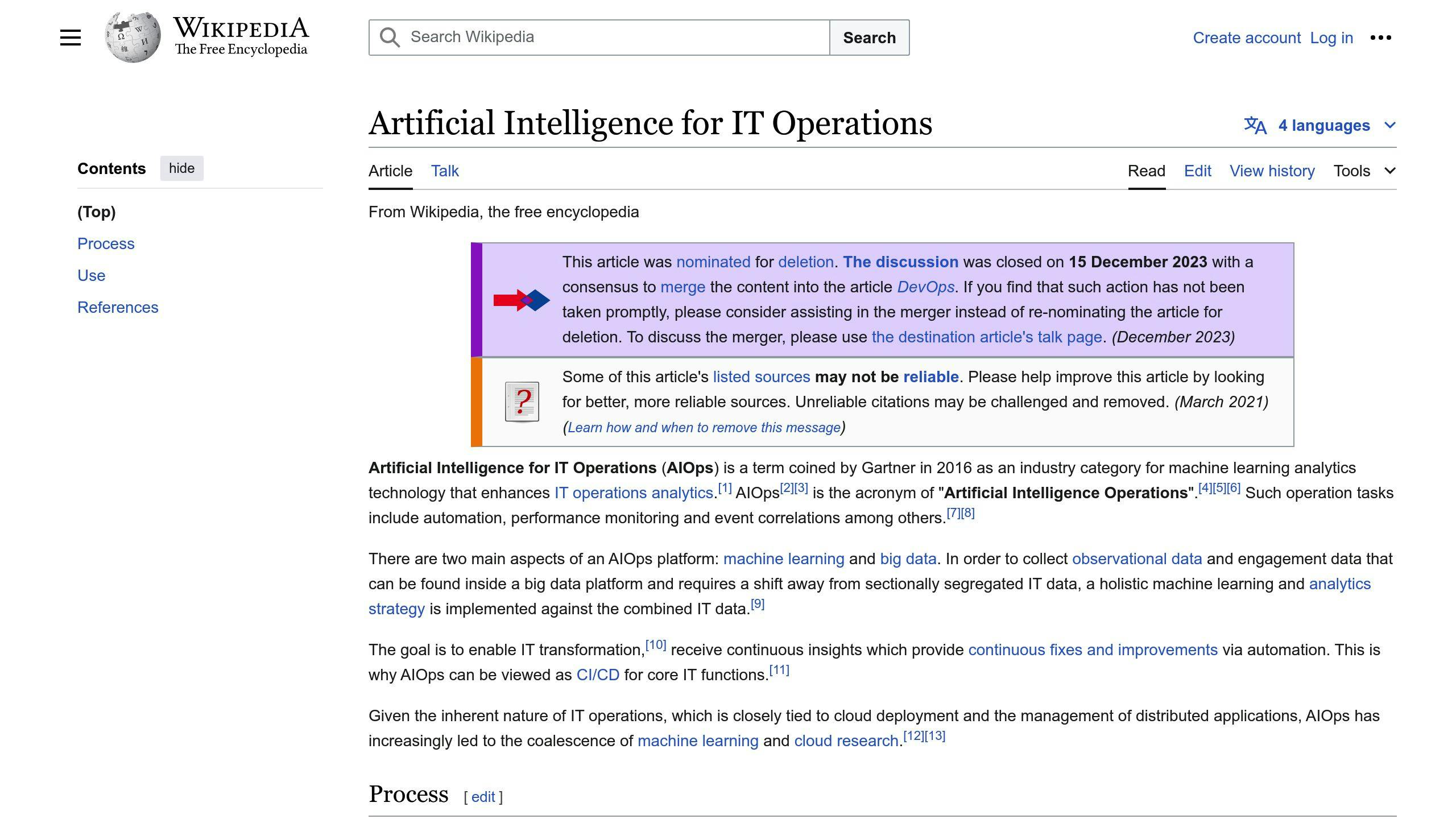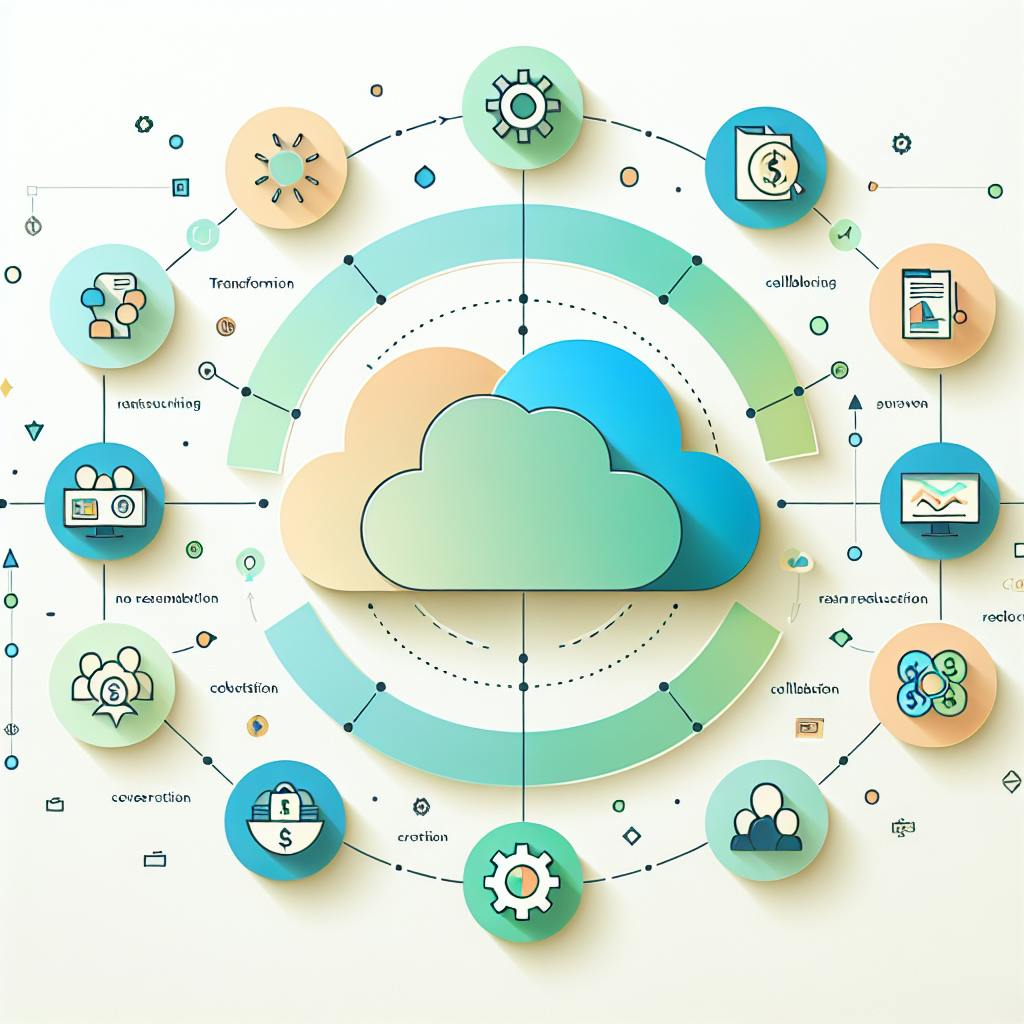Anomaly Detection and AIOps are revolutionizing cybersecurity by:
- Finding unusual patterns in network behavior
- Using AI to analyze and respond to threats quickly
- Automating IT tasks and centralizing controls
- Providing faster, smarter threat management
Here's a quick overview of how they work together:
| Feature | Anomaly Detection | AIOps |
|---|---|---|
| Purpose | Identifies unusual patterns | Manages IT operations with AI |
| Key Function | Spots potential threats | Analyzes data and automates responses |
| Benefits | Detects unknown threats | Reduces alert fatigue, speeds up response |
| Application | Network traffic, user behavior | IT infrastructure, security operations |
By combining these technologies, organizations can:
- Detect more threats, including new and complex ones
- Reduce false alarms and focus on real issues
- Respond to incidents faster, often automatically
- Predict and prevent future security problems
This article explains how Anomaly Detection and AIOps work, their benefits for cybersecurity, and how to implement them in your organization.
Related video from YouTube
2. The Problem
Today's digital world brings big challenges for keeping computer systems safe. As technology grows, so do the risks.
2.1 Complex Computer Systems
Companies now use many different computer systems:
- More devices connect to networks
- Many businesses use cloud services
- Different types of technology work together
This makes it hard for IT teams to see and protect everything.
2.2 New Cyber Threats
As computer systems change, so do the ways attackers try to break in:
- Some use AI to make smarter attacks
- Some attacks stay hidden for a long time
- Some threats can change to avoid being caught
These new threats are harder to spot and stop.
2.3 Old Safety Methods Fall Short
The usual ways of keeping computers safe don't work as well anymore:
| Problem | What It Means | Why It's Bad |
|---|---|---|
| Only reacts to known threats | Waits for attacks to happen | Can't stop new, unknown threats |
| Looks for known bad programs | Checks for specific virus patterns | Misses new viruses |
| Needs people to check threats | Humans must look at each alert | Takes too long, people make mistakes |
| Can't tell normal from odd | Doesn't understand usual behavior | Gives too many false alarms |
These problems show why we need better ways to keep computer systems safe. We need tools that can:
- See everything in the network
- Spot threats quickly
- Respond without waiting for humans
New safety methods must work better against today's complex threats and protect the many different computer systems companies use.
3. Anomaly Detection in Cybersecurity
Anomaly detection helps keep computer systems safe by finding unusual activities that might be threats.
3.1 What is Anomaly Detection?
Anomaly detection finds rare events or behaviors that don't match normal patterns. In cybersecurity, it helps spot hidden threats in networks.
Anomaly detection does these things:
- Watches networks all the time for odd events
- Looks at data to find unusual patterns
- Compares real data to what's expected
- Marks behaviors that don't fit normal patterns
3.2 Types of Anomalies
There are three main types of anomalies in cybersecurity:
| Type | What it means | Example |
|---|---|---|
| Network | Unusual network behavior | Sudden big increase in traffic |
| Application Performance | Problems in how apps work | Apps suddenly become very slow |
| Web Application Security | Odd behavior in web apps | Attacks on websites |
Knowing these types helps security teams find and fix different kinds of threats.
3.3 How Anomaly Detection Works
Anomaly detection uses smart computer programs to look at lots of data and find possible threats. Here's how it works:
- Collect Data: Gather information from networks, system records, and user actions.
- Clean Data: Remove useless information to make the data ready for checking.
- Set Normal: Figure out what normal behavior looks like.
- Keep Watching: Compare current activities to what's normal.
- Send Alerts: Mark big differences as possible threats and tell security teams.
By using these steps, anomaly detection can find many kinds of security threats, such as:
- Fake money transfers
- People breaking into networks
- Insider threats
- Computer viruses
Anomaly detection is good at finding new threats that haven't been seen before, which makes it very useful for keeping computer systems safe.
4. AIOps: AI for IT Operations

AIOps uses AI and machine learning to help manage IT systems and keep them safe. It looks at lots of data to find and fix problems quickly.
4.1 What is AIOps?
AIOps has four main parts:
| Part | What it does |
|---|---|
| Collects Data | Gathers information from different IT sources |
| Checks Data Quickly | Looks at data right away to understand what's happening |
| Uses AI to Work | Does tasks and makes choices without human help |
| Learns and Gets Better | Keeps learning to do its job better over time |
These parts work together to help manage complex IT systems.
4.2 How AIOps Helps IT Management
AIOps fixes many IT problems:
- Joins Data: It brings together information from many places, so you can see everything at once.
- Reduces Alerts: It uses smart programs to show only the most important warnings, so IT teams don't get overwhelmed.
- Finds Problems Early: It can spot issues before they cause big troubles.
- Uses Resources Well: It helps use computer power and storage in the best way, which saves money.
- Does Tasks Automatically: It does many jobs on its own, which means less work for people and fewer mistakes.
4.3 AIOps and Keeping Computers Safe
AIOps helps protect computer systems in these ways:
- Spots Threats Quickly: It looks at lots of data fast to find possible dangers.
- Finds Odd Things: It knows what's normal and can spot when something strange happens.
- Responds on Its Own: For some safety issues, it can take action right away without waiting for a person.
- Guesses Future Risks: It uses old information to guess what might go wrong in the future.
- Always Improves: As new dangers come up, AIOps gets better at finding and stopping them.
sbb-itb-9890dba
5. Combining Anomaly Detection and AIOps
Putting together anomaly detection and AIOps makes computer security stronger. It helps find and stop threats in big, complex computer systems.
5.1 How They Work Together
Anomaly detection finds odd things, and AIOps uses smart computer programs to understand and act on this information quickly.
| Anomaly Detection | AIOps |
|---|---|
| Finds unusual patterns | Gathers data from many places |
| Marks possible threats | Looks at current and past data |
| Spots unknown issues | Uses smart programs to understand |
| Adjusts to normal changes | Takes action based on what it learns |
Working together, they help protect computer systems better and faster.
5.2 Good Things About Using Both
Using anomaly detection and AIOps together helps in many ways:
- Finds More Threats: Can spot more kinds of dangers, even new ones.
- Less False Alarms: AIOps helps understand if something odd is really a threat.
- Acts Faster: Can start fixing problems as soon as they're found.
- Stops Problems Early: Can guess and fix issues before they cause trouble.
- Saves Time: Does many jobs on its own, so people can focus on big problems.
5.3 Dealing with Threats Right Away
Using both tools helps handle threats as they happen:
- Always Watching: Looks at everything all the time to find odd things.
- Connects the Dots: When something strange happens, it checks if it's linked to other issues.
- Quick Action: For some threats, it can start fixing them without waiting for a person.
- Gets Better Over Time: As it sees new threats, it learns how to spot and stop them better.
6. Key Benefits
Using Anomaly Detection and AIOps together in cybersecurity brings many good things for companies. Let's look at the main benefits:
6.1 Finding More Threats
When Anomaly Detection and AIOps work together, they can spot more dangers:
- Less Mistakes: AIOps uses smart computer programs to look at lots of data, which means it's better at telling real threats from false alarms.
- Sees the Whole Picture: By working together, these tools can spot complex threats that might be missed otherwise.
- Gets Smarter: As new dangers come up, the system learns and gets better at finding them.
| What It Does | How It Helps |
|---|---|
| Fewer False Alarms | Tells the difference between real threats and normal odd things |
| Finds Hidden Patterns | Spots sneaky attacks by looking at small clues |
| Always Learning | Gets better at finding threats over time |
6.2 Seeing More of What's Happening
Anomaly Detection and AIOps working together help see more of what's going on in computer networks:
- Watches All the Time: Keeps an eye on network traffic and behavior non-stop to catch odd things right away.
- Understands the Big Picture: Looks at information from many places to really understand possible threats.
- Knows What's Connected: Finds and sorts out devices on the network to keep things safer.
These tools can quickly find where attacks are coming from and check devices connected to the network, which helps see what's happening in all parts of the system.
6.3 Fixing Problems Faster
When Anomaly Detection and AIOps team up, they can deal with issues more quickly:
- Quick First Look: AIOps can quickly check data to figure out what's wrong and how bad it might be.
- Sorts Out What's Important: Automatically puts problems in order based on how serious they are, so the worst ones get fixed first.
- Stops Threats on Its Own: For some problems, the system can take action right away without waiting for a person.
This means IT workers can focus on solving big problems instead of doing small, repetitive tasks.
6.4 Guessing Future Threats
AIOps and Anomaly Detection together can help guess what threats might come in the future:
- Looks at Patterns: By checking old data and current trends, the system can spot new threats before they become big problems.
- Keeps Things Running: AIOps can guess when things might break, so they can be fixed before causing trouble.
- Finds Weak Spots: Always checks the IT setup to find places where attackers might get in, so they can be fixed early.
This way of thinking ahead not only makes things safer but also helps save time and money by stopping problems before they start.
7. Implementation Guide
This guide shows how to add Anomaly Detection and AIOps to your computer safety plan. It covers the main steps, possible problems, and good ways to make it work well.
7.1 Integration Steps
1. Check Your Current Setup
Look at what you have now:
- List all your data sources and systems
- See how good and easy to use your data is
- Find out what safety tools you have and what you're missing
2. Set Clear Goals
Decide what you want to achieve, like:
- Cutting down on false alarms by a certain amount
- Fixing problems faster
- Keeping your systems running more of the time
3. Pick the Right Tools
Choose tools that:
- Work well with what you already have
- Can grow as you need more
- Come with good help from the maker
4. Plan How to Handle Data
Make a good plan for your data:
- Put all your data in one place
- Clean up your data to make it better
- Set rules for how to use and keep data safe
5. Start Small, Then Grow
- Try it out in a small area first
- Ask people what they think and make it better
- Slowly add it to other parts of your system
7.2 Possible Problems
| Problem | What It Is | How to Fix It |
|---|---|---|
| Data Issues | Data might be wrong or not fit together | Clean up data and use the same format for all |
| Not Enough Know-How | People might not know how to use new tech | Train your team or hire experts |
| People Don't Want Change | Teams might not like new ways of working | Show why the new way is good and help people learn |
| Keeping Data Safe | Worry about private info getting out | Use strong safety measures and follow data rules |
7.3 Tips for Success
1. Start with Clear Examples
Focus on areas where the new tools can help right away, like:
- Cutting down on too many alerts
- Guessing when things might break
- Fixing common problems without people
2. Work Together
Make a team with people from:
- IT
- Safety
- Data experts
- Different parts of your business
3. Keep Learning and Getting Better
- Check and update your system often
- Ask users what they think
- Keep up with new ideas in this tech
4. Mix Computers and People
- Let computers do some things on their own
- Have people check the big choices
- Slowly let computers do more as you trust them
8. Future Outlook
8.1 New Developments
The world of computer safety is changing fast. Here are some new things we might see:
- Smarter Threat Spotting: New computer programs will find dangers faster and better. They'll keep learning about new threats to keep systems safer.
- Computer Safety Helpers: We might see smart computer programs that can find and stop threats on their own. This means safety systems will act faster to protect networks.
- Better Safety for Connected Devices: As more devices connect to the internet, there will be new ways to keep them safe. This includes better ways to lock information and check if devices are safe to use.
- Using Blockchain for Safety: More people might use blockchain to keep networks of connected devices safe. This makes it harder for attackers to break in.
8.2 Things That Will Get Better
We can expect these things to improve:
- Better Information: People will work on making sure the information used by safety programs is good. This will help find odd things and guess future threats more accurately.
- Working Well with Other Tools: New safety programs will work better with tools companies already use. This will help give better advice on how to stay safe.
- Guessing New Attacks: As computer programs get smarter, they'll be better at guessing new kinds of attacks before they happen.
- Understanding Odd Behavior: Safety programs will get better at spotting when something strange is happening that might be a threat.
8.3 How Smart Computers Will Help More
Smart computer programs (AI) will do more to keep systems safe:
| What AI Will Do | How It Helps |
|---|---|
| Stop Threats on Its Own | Takes care of common problems without people |
| Run Safety Tools Together | Makes different safety tools work as a team |
| Learn from Attacks | Gets better at stopping tricks used by attackers |
| Raise Questions | Makes us think about keeping information private and using AI the right way |
As smart computers get better at safety, companies that start using them early will be ready to stop new kinds of computer attacks. But we'll also need to think carefully about how to use these tools in the right way.
9. Conclusion
9.1 Main Points
Using anomaly detection and AIOps for computer safety brings big benefits:
| Benefit | Description |
|---|---|
| Finds threats early | Spots dangers before they cause harm |
| Watches all the time | Checks network activities non-stop |
| Fixes issues quickly | Handles problems without waiting |
| Shows safety clearly | Gives a full picture of how safe things are |
| Guesses future risks | Helps prepare for possible threats |
9.2 Why Use These Tools
Companies should use these new tools because they:
- Help stay safe from new threats
- Make work smoother and cut down on problems
- Use people and money better to stop big threats
- Make safety stronger with smart computer help
- Change quickly to stop new kinds of attacks



